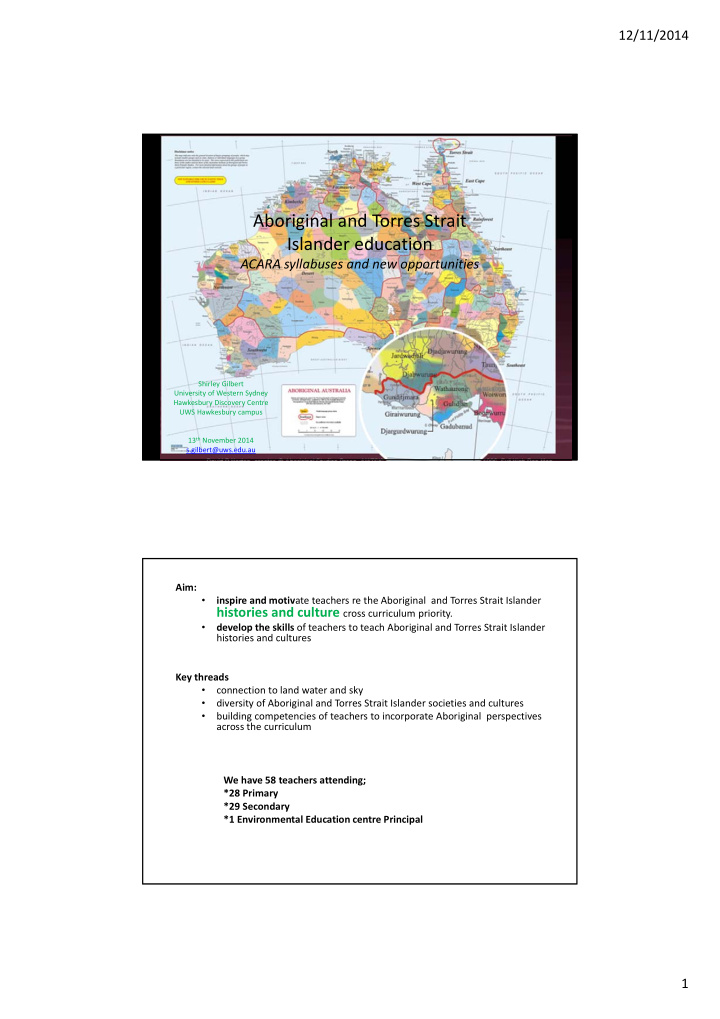



12/11/2014 Aboriginal and Torres Strait Islander education ACARA syllabuses and new opportunities Shirley Gilbert University of Western Sydney Hawkesbury Discovery Centre UWS Hawkesbury campus 13 th November 2014 s.gilbert@uws.edu.au Aim: • inspire and motiv ate teachers re the Aboriginal and Torres Strait Islander histories and culture cross curriculum priority. • develop the skills of teachers to teach Aboriginal and Torres Strait Islander histories and cultures Key threads • connection to land water and sky • diversity of Aboriginal and Torres Strait Islander societies and cultures • building competencies of teachers to incorporate Aboriginal perspectives across the curriculum We have 58 teachers attending; *28 Primary *29 Secondary *1 Environmental Education centre Principal 1
12/11/2014 Level 1 – Graduate Level 2 & 3 – Proficient Level 4 & 5 – Highly Accomplished Level 5 & 6 – Lead Focus Area 1.4: Strategies for teaching Aboriginal and Torres Strait Islander students. At Graduate level Focus Area 1.4: Provide opportunities for students to develop understanding of and respect for Aboriginal and Torres Strait Islander histories, cultures and languages. Level 2&3 – Proficient Focus Area 1.4: Design and implement effective teaching strategies that are responsive to the local community and cultural setting, linguistic background and histories of Aboriginal and Torres Strait Islander students. 2
12/11/2014 Focus Area 2.4: Understand and respect Aboriginal and Torres Strait Islander people to promote reconciliation between Indigenous and non ‐ Indigenous Australians. At Graduate level Focus Area 2.4: Demonstrate broad knowledge and understanding of the impact of culture, cultural identity and linguistic background on the education of students from Aboriginal and Torres Strait Islander backgrounds. Level 2&3 – Proficient Focus Area 2.4: Provide opportunities for students to develop understanding of and respect for Aboriginal and Torres Strait Islander histories, cultures and languages. https://8ways.wikispaces.com/ 3
12/11/2014 Australia 1788–1900: the nature and impact of colonisation and contact pre ‐ contact Aboriginal culture recall the main features of Aboriginal culture prior to British colonisation 4
12/11/2014 5
12/11/2014 Year 1 Level Description PRESENT AND PAST FAMILY LIFE 1930’s The key inquiry questions at this year level are: • How has family life changed or remained the same over time? • How can we show that the present is different from or similar to the past? Bendoc • How do we describe the sequence of time? Places and people Events in life Places importance on time as a continuum 1958 2015 1940’s 1992 Sydney 1971 Delegate Taronga park 6
12/11/2014 http://www.myplace.edu.au/home.html 7
12/11/2014 Robert Campbell Jnr Life in the Aboriginal Camp, 1989 acrylic on board 128 × 250cm PRESENT AND PAST FAMILY LIFE Robert Campbell Jnr Untitled 8.2.86, 1986 acrylic on bark and board 72 × 86cm 8
12/11/2014 'A view of Sydney Cove, NSW 1804' Edward Dayes Reproduced courtesy of Mitchell Library State Library of NSW Jonathon Jones Oysters and Teacups For his Biennale work it’s the Aboriginal shell midden that is the object of inspiration; ancient mounds of shell artefacts demonstrating Indigenous interrelationship with kin, country and marine life. Evidence of absence is not absence of evidence These mounded middens are culturally very important to Aboriginal people and archaeologically as the source of information about the first Australians. Midden material is widespread in the coastal areas. Every headland invariably reveals this material, often seen along trails and walking tracks, showing widespread Aboriginal occupation of this landscape. 9
12/11/2014 Secondary ideas Middle school approaches to learning through the environment Using water /land /sea Teaching mathematics and geographical outcomes in nature. Science outcomes 10
12/11/2014 differing experiences of contact between Aboriginal and non ‐ Aboriginal peoples These could include: • impact of disease • land disputes dispossession • • massacres and frontier wars • Aboriginal responses to dispossession Physical dispossession Talking about the images Avrill Quaill – Land was cleared and fenced and with these acts the food sources of the local Aboriginal people disappeared, leading to the eventual disappearance of the people themselves. To a large extent non-Indigenous Australians were able to gain economic independence because the Indigenous Australians lost it. 11
12/11/2014 12
12/11/2014 13
12/11/2014 14
12/11/2014 Mutton Birds and Tasmania (Geography and Science secondary) iBook http://public.roarfilm.com/moonbird/Moonbird ‐ LATEST.epub COUNTRY SERIES: Two short DVDs about Country. Coastal Places https://www.youtube.com/watch?v=ADGeJmPWEgc Inland Places https://www.youtube.com/watch?v=AKdAW13L ‐ OY&list=PLWFK6wYaexKh ‐ y03g Mutton Birds ‐ an early years DVD about mutton birds https://www.youtube.com/watch?v= ‐ MqvB36Muzk Geography and History MEETING OF THE WATERS A journey on the marine side of Australia’s Coastal Wilderness Part 5 – Indigenous Coastal Heritage http://www.sapphirecoast.com.au/site/wp ‐ content/uploads/2013/06/Part ‐ 5 ‐ Indigenous ‐ Coastal ‐ Heritage.pdf?13eb0b More Middens http://www.arrawarraculture.com.au/fact_sheets/pdfs/08_Arrawarra_Midden.pdf http://www.shellharbour.nsw.gov.au/filedata/panels/atsi/atsiposterChangesToTheLandscape.pdf Local History and culture links http://dictionaryofsydney.org/entry/first_people_of_the_cooks_river http://www.colacotway.vic.gov.au/Files/FinalMasterReportBlackfellasWell2006.pdf 15
Recommend
More recommend